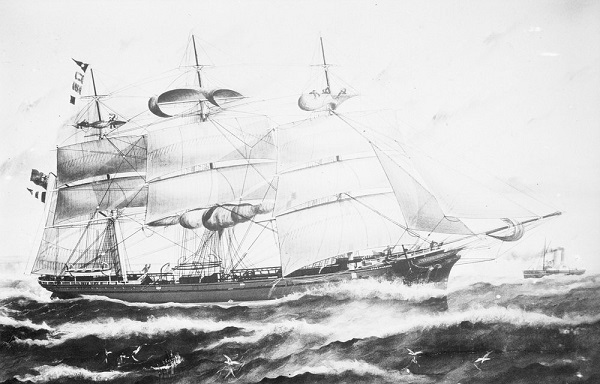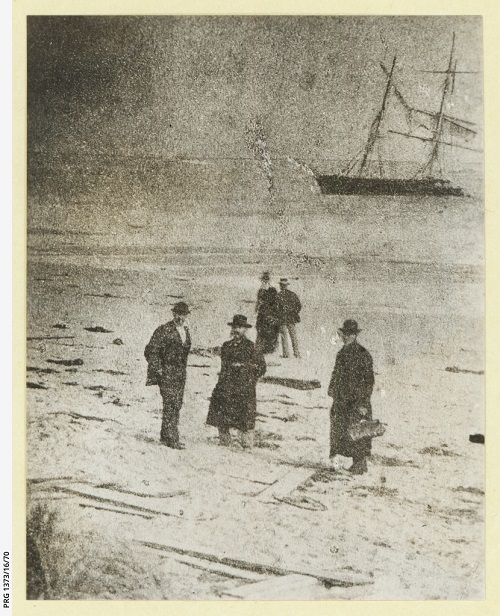The Star of Greece
Today the Star of Greece we know is a restaurant, on the coast at Willunga. It takes its name from a ship that was wrecked nearby, on Friday the 13th of July 1888. The wreck of the Star of Greece was hailed by many, as a shameful day in the history of South Australia.

Image of the Star of Greece
State Library of Victoria. (Malcolm Brodie Collection)
The Star of Greece was a three-masted iron ship of 1,257 tons displacement. She was built in Belfast, Ireland in 1868, at the Harland & Wolff shipyard, for her owners J.P. Corry & Co. She held the record for the round trip from the UK to Calcutta and return, via the Cape of Good Hope. It took 80 days outwards and 83 days for the return, with 10 days in Calcutta. This time was never beaten by any other sailing ship1. She was later transferred to the Australian trade in 1888. Her young Captain, H. R. Harrower, who was 29 years of age, was in his third year as captain of a vessel. This was the third ship he had captained for this company, and was his first visit to Adelaide, where his sister, Mrs. J Bishop, his only living relative, resided 2. Mrs. Bishop was a resident of Woodville.
The Star of Greece had loaded 16,002 bags of wheat, bound for the United Kingdom. Whilst in Port Adelaide, two crew members had left the ship. One had deserted and the other had been transferred to the Star of Erin. This was to cause confusion later on, as to the number of persons aboard the vessel. At 6.30p.m. the 12th of July 1888, she left the anchorage at Semaphore3. The captains’ idea was to be tacking through Backstairs Passage, in daylight the following day.After the event, men of the sea were consulted as to this approach. Some agreed in its practice, others felt it was foolhardy. But it was the events that occurred ashore, after the beaching, that caused most of the uproar. The vessel sailed into a very strong South Westerly gale, late on the evening of the 12th of July. The wind and undercurrent pushed the vessel 15 miles off course, and towards the shore. In the early hours of the 13th, the vessel was pushed on to the sand, in shallow water, near the town of Willunga. Prior to beaching the Chief Officer had been sent forward to release the anchor, it did not hold. Before the second anchor could be dropped, the vessel had beached. Almost immediately in the pounding seas, the ship began to break up. It was about 3.00 a.m. when the ship came to grief, just 200 meters from the Port Willunga Jetty. Distress flares failed to work as they were too damp to light. At 7.00 a.m. a boy walking along the beach raised the alarm. At 9.00 a.m. the chief officer, who had seen the captain drown and was now in charge, attempted to swim to the shore 4.This was not possible due to the undertow. The Captain and four others had been swept away when the mizzen mast rigging, onto which they had been holding, was swept away by the rough seas. Against the chief officer’s advice, the second officer and also the carpenter attempted to swim ashore. They both drowned, and very little was found of the second officer, due to a shark attack. The chief officer identified him, by a ring on a hand and hair on the scalp recovered later in the day.
There was a delay at the telegraph office at Willunga Township, due to it not being open until 9.00 a.m. and the news, of the shipwreck, not being transmitted to the Marine Board until then. It was after 9.30.am before the authorities in Adelaide were aware that the shipwreck had occurred. Even after the Marine Board had been advised, there was a delayed reaction. The steamer Defiance was sent, a ship which had no lifeboat, only a whaleboat. The steamer Yatala, which did have a lifeboat, was then sent. Due to the lost time, the Yatala did not arrive until dusk, when it was too dark to be of any help5. As there was no rocket apparatus stationed at Willunga, Normanville, was asked to send their rocket gear. This too arrived at dusk and was of no use in the fading light. By 1p.m. the crew had realized, help was not at hand, so they made their own decisions. The chief officer and four apprentices decided to swim for shore. Even though none of them could swim they all survived. In all nine crew members survived and seventeen perished.

The wreck of the Star of Greece near Willunga
State Library of South Australia
After the shipwreck, there were two enquiries, one to establish the reason for the shipwreck, the other to establish what went wrong with the rescue operation.
The Marine Board looked into the reason for the shipwreck. They concluded that there was a manifest want of skill displayed, from the Semaphore anchorage to the approach to Backstairs Passage by daylight. Laying to windward from 9.00pm, with the main topsail aback and a gale blowing was fatal. They concluded that drunkenness played no part, and there was no blame to be attached to the Chief Officer. As the Captain was deceased there was no need to resort to a Marine Court of Inquiry6.
In the South Australian Parliament, a select Committee was convened to look into the poor response to the shipwreck, and to recommend improvements if required. The committee found that it took 14 hours after the shipwreck for any real attempt at rescue to commence. The Government lifeboat was unfit for use, as was the rocket apparatus both of them at Port Adelaide. These two items were part of the Marine Board annual inspection regime, but there was no written report of them being unfit for use, even though an inspection had only recently occurred. The Marine Board was under the impression that these two items were ready to use. Rocket apparatus had been removed from Port Willunga in 1886, with no reason given as to why it was removed. When the alarm was raised the secretary of the Marine Board requested from the Treasurer that a lifeboat be sent. The Treasurer suggested the Governor Musgrave, but this vessel had left Port Adelaide for Port Augusta. When the Chairman of the Marine Board returned to his office, his secretary advised him of the Treasurers advice, as the Governor Musgrave had sailed, both decided they could do no more. The select committee agreed that a rescue vessel should have been sent as soon as the alarm was received.
The select committee concluded that:
(a) a lifeboat and rocket apparatus should be kept at Port Adelaide, and maintained, and ready for use
(b) That all lifesaving apparatus in the Colony should be under the control of one person
(c) That Telegraph stations should be able to transmit 24 hours a day 7, days a week in a time of emergency.
Researched and compiled by Jim Nelson, a volunteer with the Campbelltown Library “Digital Diggers” group.
If you have any comments or questions regarding the information in this local history article, please contact the Local History officer on 8366 9357 or hthiselton@campbelltown.sa.gov.au
References
- Red Duster. (2017). JAMES P. CORRY & CO. - Red Duster. [online] Available at: http://www.red-duster.co.uk/wp/2016/02/11/james-p-corry-co/ [Accessed 29 Jun. 2017].
- 1888 'The Star of Greece.', The Express and Telegraph (Adelaide, SA : 1867 - 1922), 13 July, p. 2. (Second Edition), viewed 29 Jun 2017, http://nla.gov.au/nla.news-article207749024
- 1888 'THE WRECK OF THE STAR OF GREECE.', The Mercury (Hobart, Tas. : 1860 - 1954), 17 July, p. 2. , viewed 29 Jun 2017, http://nla.gov.au/nla.news-article9193963
- 1888 'DISASTROUS WRECK—STAR OF GREECE LOST.', South Australian Register (Adelaide, SA : 1839 - 1900), 23 July, p. 1. (Supplement to the South Australian Register.), viewed 29 Jun 2017, http://nla.gov.au/nla.news-article46873956
- 1888 'WRECK OF THE STAR OF GREECE.', The South Australian Advertiser (Adelaide, SA : 1858 - 1889), 21 July, p. 6. , viewed 29 Jun 2017, http://nla.gov.au/nla.news-article36435180
- 1888 'THE STAR OF GREECE ENQUIRY.', The South Australian Advertiser (Adelaide, SA : 1858 - 1889), 15 August, p. 5. , viewed 29 Jun 2017, http://nla.gov.au/nla.news-article36436725
Images
- State Library of Victoria. Malcolm Brodie Collection. STAR OF GREECE. [picture] : (Iron). H99.220/2015
[online] Available at: http://search.slv.vic.gov.au/MAIN:Everything:SLV_VOYAGER1743551 [Accessed 29 Jun. 2017]. State Library of South Australia. (2017). The 'Star of Greece' wrecked at Willunga, SA. [online] Available at: http://collections.slsa.sa.gov.au/resource/PRG+1373/16/70 [Accessed 29 Jun. 2017].
